Battle of Iwo Jima
The Battle of Iwo Jima (19 February – 26 March 1945) was a major battle in which the United States Marine Corps and Navy landed on and eventually captured the island of Iwo Jima from the Imperial Japanese Army (IJA) during World War II. The American invasion, designated Operation Detachment, had the goal of capturing the entire island, including the three Japanese-controlled airfields (including the South Field and the Central Field), to provide a staging area for attacks on the Japanese main islands.[6] This five-week battle comprised some of the fiercest and bloodiest fighting of the Pacific War of World War II.
| Battle of Iwo Jima | |||||||
|---|---|---|---|---|---|---|---|
| Part of the Pacific Theater of World War II | |||||||
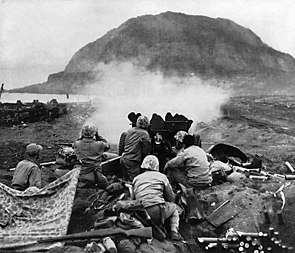 A U.S. 37 mm (1.5 in) anti-tank gun fires against Japanese cave positions in the north face of Mount Suribachi. | |||||||
| |||||||
| Belligerents | |||||||
|
|
| ||||||
| Commanders and leaders | |||||||
|
U.S. Navy: Chester W. Nimitz Raymond A. Spruance Marc A. Mitscher William H.P. Blandy U.S. Marine Corps: Holland M. Smith Harry Schmidt Graves B. Erskine Clifton B. Cates Keller E. Rockey |
Tadamichi Kuribayashi † Takeichi Nishi † Sadasue Senda † Rinosuke Ichimaru † | ||||||
| Units involved | |||||||
|
Ground units:
Naval units:
|
Ground units:
Naval Units:
Additional support units and Kamikaze | ||||||
| Strength | |||||||
|
110,000 U.S. Marines, U.S. Soldiers, U.S. Navy corpsmen, Seabees, USAAF personnel, and others 500+ ships |
20,530–21,060 troops[2] 23 tanks[3] 438 artillery pieces 33 naval guns 69 anti-tank guns ~300 anti-aircraft guns[4][5] | ||||||
| Casualties and losses | |||||||
|
26,040 total casualties 6,821 killed 2 captured but recovered[6] 19,217 wounded[2] 1 escort carrier sunk 1 fleet carrier severely damaged 1 escort carrier lightly damaged 137 tanks destroyed[7] |
17,845–18,375 dead and missing[2] | ||||||
After the heavy losses incurred in the battle, the strategic value of the island became controversial. It was useless to the U.S. Army as a staging base and useless to the U.S. Navy as a fleet base.[9] However, Navy Seabees rebuilt the landing strips, which were used as occasional landing strips for USAAF B-29s, although rarely for emergencies.[10]
The IJA positions on the island were heavily fortified, with a dense network of bunkers, hidden artillery positions, and 18 km (11 mi) of tunnels.[11][12] The American ground forces were supported by extensive naval artillery, and had complete air supremacy provided by U.S. Navy and Marine Corps aviators throughout the battle.[13]
Japanese combat deaths numbered three times the number of American deaths although, uniquely among Pacific War Marine battles, American total casualties (dead and wounded) exceeded those of the Japanese.[14] Of the 21,000 Japanese soldiers on Iwo Jima at the beginning of the battle, only 216 were taken prisoner, some of whom were captured because they had been knocked unconscious or otherwise disabled.[2] The majority of the remainder were killed in action, although it has been estimated that as many as 3,000 continued to resist within the various cave systems for many days afterwards, eventually succumbing to their injuries or surrendering weeks later.[2][15]
Despite the bloody fighting and severe casualties on both sides, the American victory was assured from the start. Overwhelming American superiority in numbers and arms as well as complete air supremacy—coupled with the impossibility of Japanese retreat or reinforcement, along with sparse food and supplies—permitted no plausible circumstance in which the Americans could have lost the battle.[16]
Joe Rosenthal's Associated Press photograph of the raising of the U.S. flag on top of the 169 m (554 ft) Mount Suribachi by six U.S. Marines became an iconic image of the battle and the American war effort in the Pacific.[17]
Background
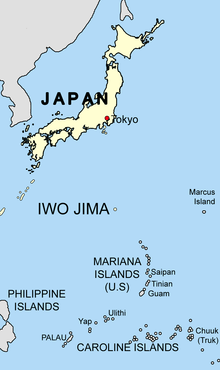
After the American capture of the Marshall Islands, and the devastating air attacks against the Japanese fortress island of Truk Atoll in the Carolines in January 1944, the Japanese military leaders reevaluated their situation. All indications pointed to an American drive toward the Mariana Islands and the Carolines. To counter such an offensive, the IJA and the Imperial Japanese Navy (IJN) established an inner line of defenses extending generally northward from the Carolines to the Marianas, and thence to Japan via the Volcano Islands, and westward from the Marianas via the Carolines and the Palau Islands to the Philippines.
In March 1944, the Japanese 31st Army, commanded by General Hideyoshi Obata, was activated to garrison this inner line. (Note that a Japanese army was about the size of an American, British Army, or Canadian Army corps. The Japanese Army had many armies, but the U.S. Army only had ten at its peak, with the 4th Army, the 6th Army, the 8th Army, and the 10th Army being in the Pacific Theater. Also, the 10th Army only fought on Okinawa in the spring of 1945.)
The commander of the Japanese garrison on Chichi Jima was placed nominally in command of Army and Navy units in the Volcano Islands.[6] After the American conquest of the Marianas, daily bomber raids from the Marianas hit the mainland as part of Operation Scavenger. Iwo Jima served as an early warning station that radioed reports of incoming bombers back to mainland Japan. This allowed Japanese air defenses to prepare for the arrival of American bombers.[6]
After the U.S. seized bases in the Marshall Islands in the battles of Kwajalein and Eniwetok in February 1944, Japanese Army and Navy reinforcements were sent to Iwo Jima: 500 men from the naval base at Yokosuka and 500 from Chichi Jima reached Iwo Jima during March and April 1944. At the same time, with reinforcements arriving from Chichi Jima and the home islands, the Army garrison on Iwo Jima reached a strength of more than 5,000 men.[6] The loss of the Marianas during the summer of 1944 greatly increased the importance of the Volcano Islands for the Japanese, who were afraid that the loss of these islands would facilitate American air raids against the Home Islands, disrupting war manufacturing and severely damaging civilian morale.[6]
Final Japanese plans for the defense of the Volcano Islands were overshadowed by several factors:
- The Imperial Japanese Navy had already lost almost all of its power, and it could not prevent American landings.
- Aircraft losses in 1944 had been so heavy that, even if war production were not affected by American air attacks, combined Japanese air strength was not expected to increase to 3,000 warplanes until March or April 1945.
- These aircraft could not be used from bases in the Home Islands against Iwo Jima because their range was not more than 900 km (560 mi).
- Available warplanes had to be hoarded to defend Taiwan and the Japanese Home Islands from any attack.[6]
- There was a serious shortage of properly trained and experienced pilots and other aircrew to man the warplanes Japan had because such large numbers of pilots and crewmen had perished fighting over the Solomon Islands and during the Battle of the Philippine Sea in mid-1944.
In a postwar study, Japanese staff officers described the strategy that was used in the defense of Iwo Jima in the following terms:
In the light of the above situation, seeing that it was impossible to conduct our air, sea, and ground/ operations on Iwo Island [Jima] toward ultimate victory, it was decided that to gain time necessary for the preparation of the Homeland defense, our forces should rely solely upon the established defensive equipment in that area, checking the enemy by delaying tactics. Even the suicidal attacks by small groups of our Army and Navy airplanes, the surprise attacks by our submarines, and the actions of parachute units, although effective, could be regarded only as a strategical ruse on our part. It was a most depressing thought that we had no available means left for the exploitation of the strategical opportunities which might from time to time occur in the course of these operations.[18]
— Japanese Monograph No. 48
At the end of the Battle of Leyte in the Philippines, the Allies were left with a two-month lull in their offensive operations before the planned invasion of Okinawa. Iwo Jima was considered strategically important: it provided an air base for Japanese fighter planes to intercept long-range B-29 Superfortress bombers. In addition, it was used by the Japanese to stage nuisance air attacks on the Mariana Islands from November 1944 through January 1945. The capture of Iwo Jima would eliminate these problems. The base would be available for P-51 Mustang fighters to escort and protect the bombers.[6] In the end, none of these strategic reasons for the operation were valid.
American intelligence sources were confident that Iwo Jima would fall in one week. In light of the optimistic intelligence reports, the decision was made to invade Iwo Jima and the operation was given the code name Operation Detachment.[6] American forces failed to anticipate that the Japanese would prepare a complex and deep defense, much like on Peleliu in the fall of 1944. So successful was the Japanese preparation that it was discovered after the battle that the hundreds of tons of Allied bombs and thousands of rounds of heavy naval gunfire had left the Japanese defenders almost undamaged and ready to inflict losses on the U.S. Marines.
Planning and preparation
Japanese preparations
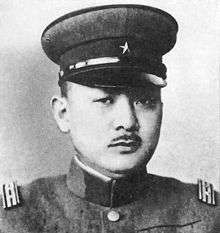
By June 1944, Lieutenant General Tadamichi Kuribayashi was assigned to command the defense of Iwo Jima. Kuribayashi knew that Japan could not win the battle, but he hoped to inflict massive casualties on the American forces, so that the United States and its Australian and British allies would reconsider carrying out the invasion of Japan Home Islands.
While drawing inspiration from the defense in the Battle of Peleliu, Kuribayashi designed a defense that broke with Japanese military doctrine. Rather than establishing his defenses on the beach to face the landings directly, he created strong, mutually supporting defenses in depth using static and heavy weapons such as heavy machine guns and artillery. Takeichi Nishi's armored tanks were to be used as camouflaged artillery positions. Because the tunnel linking the mountain to the main forces was never completed, Kuribayashi organized the southern area of the island in and around Mount Suribachi as a semi-independent sector, with his main defensive zone built up in the north. The expected American naval and air bombardment further prompted the creation of an extensive system of tunnels that connected the prepared positions, so that a pillbox that had been cleared could be reoccupied. This network of bunkers and pillboxes favored the defense. For instance, The Nano Bunker (Southern Area Islands Naval Air HQ), which was located east of Airfield Number 2, had enough food, water, and ammunition for the Japanese to hold out for three months. The bunker was 90 feet deep and had tunnels running in various directions. Approximately 500 55-gallon drums filled with water, kerosene, and fuel oil for generators were located inside the complex. Gasoline-powered generators allowed for radios and lighting to be operated underground.[19]
By February 19, 1945, the day the Americans invaded, 18 kilometres (11 mi) of a planned 27 kilometres (17 mi) of tunnel network had been dug. Besides the Nanpo Bunker, there were numerous command centers and barracks that were 75 feet deep. Tunnels allowed for troop movement to go undetected to various defense positions.[20]
Hundreds of hidden artillery and mortar positions along with land mines were placed all over the island. Among the Japanese weapons were 320 mm spigot mortars and a variety of explosive rockets.[21]
Nonetheless, the Japanese supply was inadequate. Troops were supplied 60% of the standard issue of ammunition sufficient for one engagement by one division, and food and forage for four months.[22]
Numerous Japanese snipers and camouflaged machine gun positions were also set up. Kuribayashi specially engineered the defenses so that every part of Iwo Jima was subject to Japanese defensive fire. He also received a handful of kamikaze pilots to use against the enemy fleet. Three hundred and eighteen American sailors were killed by kamikaze attacks during the battle. However, against his wishes, Kuribayashi's superiors on Honshu ordered him to erect some beach defenses.
American preparations
—Chester W. Nimitz[23]
Starting on 15 June 1944, the U.S. Navy and the U.S. Army Air Forces began naval bombardments and air raids against Iwo Jima, which would become the longest and most intense in the Pacific theater.[24] These would contain a combination of naval artillery shellings and aerial bombings that went on for nine months. On 17 February, the destroyer escort USS Blessman sent Underwater Demolition Team 15 (UDT-15) toward Blue Beach for reconnaissance. The Japanese infantry fired on them, killing one American diver. On the evening of 18 February, the Blessman was hit by a bomb from a Japanese aircraft, killing 40 sailors, including 15 members of her UDT.
Unaware of Kuribayashi's tunnel defense system, many of the Americans assumed the majority of the Japanese garrison were killed by the constant bombing raids.
Pre-landing bombardment
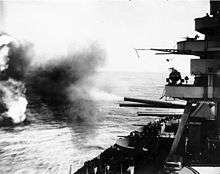
Maj. Gen. Harry Schmidt, commander of the Marine landing force, requested a 10-day heavy shelling of the island immediately preceding the mid-February amphibious assault. However, Rear Adm. William H. P. Blandy, commander of the Amphibious Support Force (Task Force 52), did not believe such a bombardment would allow him time to replenish his ships' ammunition before the landings; he thus refused Schmidt's request. Schmidt then asked for nine days of shelling; Blandy again refused and agreed to a three-day bombardment. This decision left much hard feelings among the Marines. After the war, Lieut. Gen. Holland M. "Howlin' Mad" Smith, commander Expeditionary Troops (Task Force 56, which consisted of Schmidt's Fifth Amphibious Corps), bitterly complained that the lack of naval gunfire had cost Marine lives during the entire Allied island campaign.[25]
Each heavy warship was given an area on which to fire that, combined with all the ships, covered the entire island. Each warship fired for approximately six hours before stopping for a certain amount of time. Poor weather on D minus 3 led to uncertain results for that day's bombardment. On D minus 2, the time and care that the Japanese had taken in preparing their artillery positions became clear. When heavy cruiser USS Pensacola got within range of shore batteries, the ship was quickly hit 6 times and suffered 17 crew deaths. Later, 12 small craft attempting to land an underwater demolition team were all struck by Japanese rounds and quickly retired. While aiding these vessels, the destroyer USS Leutze was also hit and suffered 7 crew deaths. On D minus 1, Adm. Blandy's gunners were once again hampered by rain and clouds. Gen. Schmidt summed up his feelings by saying, "We only got about 13 hours worth of fire support during the 34 hours of available daylight."[26]
The limited bombardment had questionable impact on the enemy due to the Japanese being heavily dug-in and fortified. However, many bunkers and caves were destroyed during the bombing, giving it some limited success. The Japanese had been preparing for this battle since March 1944, which gave them a significant head start.[27] By the time of the landing, about 450 American ships were located off Iwo Jima. The entire battle involved about 60,000 U.S. Marines and several thousand U.S. Navy Seabees.[28]
Opposing forces
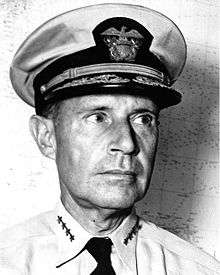

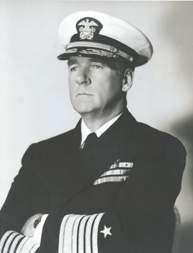


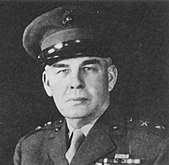

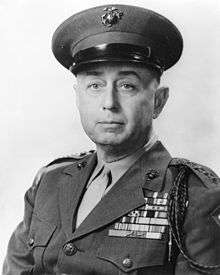

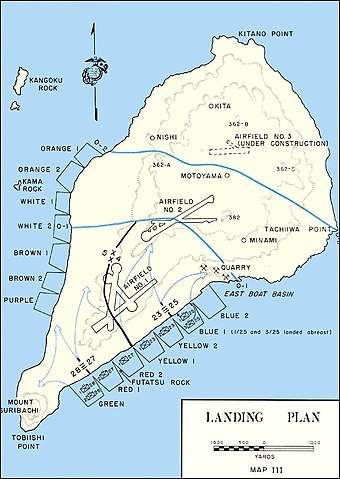
.jpg)
American order of battle
U.S. Fifth Fleet [29]
Admiral Raymond A. Spruance in heavy cruiser Indianapolis
- Joint Expeditionary Force (Task Force 51) – Vice Adm. Richmond Kelly Turner in amphibious command ship Eldorado
- Amphibious Support Force (Task Force 52) – Rear Adm. William H.P. Blandy in amphibious command ship Estes
- Attack Force (Task Force 53) – Rear Adm. Harry W. Hill in amphibious command ship Auburn
Expeditionary Troops (Task Force 56)
Lieutenant General Holland M. Smith, USMC
- Chief of Staff: Col. Dudley S. Brown, USMC
- Personnel officer (G-1): Col. Russell N. Jordahl, USMC
- Intelligence officer (G-2): Col. Edmond J. Buckley, USMC
- Operations officer (G-3): Col. Kenneth H. Weir, USMC
- Logistics officer (G-4): Col. George R. Rowan, USMC
V Amphibious Corps[30][31]
Major General Harry Schmidt, USMC
- Chief of Staff: Brig. Gen. William W. Rogers, USMC
- Personnel officer (G-1): Col. David A. Stafford, USMC
- Intelligence officer (G-2): Col. Thomas R. Yancey, USA
- Operations officer (G-3): Col. Edward A. Craig, USMC
- Logistics officer (G-4): Col. William F. Brown, USMC
- 8th Marine Field Depot (shore party command): Col. Leland S. Swindler
- Landing Force Air Support Control Unit 1: Col. Vernon E. Megee
- 62nd Seabees
Southern sector (Green and Red beaches):
- 5th Marine Division (25,884 officers and enlisted)
- Division Commander: Maj. Gen. Keller E. Rockey
- Assistant Division Commander: Brig. Gen. Leo D. Hermle
- Chief of Staff: Col. Ray A. Robinson
- Personnel officer (G-1): Col. John W. Beckett
- Intelligence officer (G-2): Lt. Col. George A. Roll
- Operations officer (G-3): Col. James F. Shaw Jr.
- Logistics officer (G-4): Col. Earl S. Piper
- 26th Marine Regiment: Col. Chester B. Graham
- 27th Marine Regiment: Col. Thomas A. Wornham
- 28th Marine Regiment: Col. Harry B. Liversedge
- 13th (Artillery) Marine Regiment: Col. James D. Waller
- 5th Tank Battalion: Lt. Col. William R. Collins
- 5th Marine Shore Party Regiment (5th Marine Pioneers and 31st Seabees)
Northern sector (Yellow and Blue beaches):
- 4th Marine Division (24,452 officers and enlisted)
- Division Commander: Maj. Gen. Clifton B. Cates
- Assistant Division Commander: Brig. Gen. Franklin A. Hart
- Chief of Staff: Col. Merton J. Batchelder
- Personnel officer (G-1): Col. Orin H. Wheeler
- Intelligence officer (G-2): Lt. Col. Gooderham L. McCormick
- Operations officer (G-3): Col. Edwin A. Pollock
- Logistics officer (G-4): Col. Matthew C. Horner
- 23rd Marine Regiment: Col. Walter W. Wensinger
- 24th Marine Regiment: Col. Walter I. Jordan
- 25th Marine Regiment: Col. John R. Lanigan
- 14th (Artillery) Marine Regiment: Col. Louis G. DeHaven
- 4TH Marine Pioneers and 133rd Seabees (shore party)
- 147th Infantry Regiment (U.S. Army)
Floating reserve (committed to center sector 22 Feb):
- 3rd Marine Division (19,597 officers and enlisted)
- Division Commander: Maj. Gen. Graves B. Erskine
- Assistant Division Commander: Brig. Gen. William A. Worton
- Chief of Staff: Col. Robert E. Hogaboom
- Personnel officer (G-1): Maj. Irving R. Kriendler
- Intelligence officer (G-2): Lt. Col. Howard J. Turton
- Operations officer (G-3): Col. Arthur H. Butler
- Logistics officer (G-4): Col. James D. Hittle
- 3rd Marine Regiment (Floating reserve): Col. James A. Stuart
- 9th Marine Regiment: Col. Howard N. Kenyon
- 21st Marine Regiment: Col. Hartnoll J. Withers
- 12th (Artillery) Marine Regiment: Lt.Col. Raymond F. Crist Jr.
Japanese order of battle
21,060 total men under arms
Lieut. General Tadamichi Kuribayashi, commanding
Colonel Tadashi Takaishi, chief of staff
Army
- 109th Division
- 145th Infantry Regiment
- 17th Mixed Infantry Regiment
- 26th Tank Regiment
- 2nd Mixed Brigade
Navy
- 125th Anti-Aircraft Defense Unit
- 132nd Anti-Aircraft Defense Unit
- 141st Anti-Aircraft Defense Unit
- 149th Anti-Aircraft Defense Unit
First day – 19 February 1945
_approach_Iwo_Jima%3Bfig14.jpg)
.jpg)
.jpg)
.jpg)

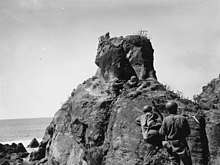
-5_in_Iwo_Jima_1945.jpg)
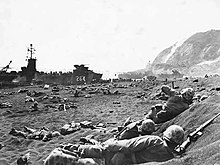
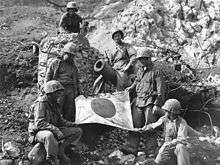
Amphibious landing
During the night, Vice Adm. Marc A. Mitscher's Task Force 58, a huge carrier force, arrived off Iwo Jima. Also in this flotilla was Adm. Raymond A. Spruance, overall commander for the invasion, in his flagship, the heavy cruiser USS Indianapolis. "Howlin' Mad" Smith was once again deeply frustrated that Mitscher's powerful carrier group had been bombing the Japanese home islands instead of softening up the defenses of Iwo Jima. Mitscher's fliers did contribute to the additional surface-ship bombardment that accompanied the formation of the amphibious craft.[32]
Unlike the days of the pre-landing bombardment, D-Day dawned clear and bright.[32] At 08:59, one minute ahead of schedule, the first wave of Marines landed on the beaches of the southeastern coast of Iwo Jima. Major Howard Connor, 5th Marine Division signal officer, had six Navajo code talkers working around the clock during the first two days of the battle. These six sent and received over 800 messages, all without error. Connor later stated, "Were it not for the Navajos, the Marines would never have taken Iwo Jima."[33]
Situation on the beaches
Unfortunately for the landing force, the planners at Pearl Harbor had completely misjudged the situation that would face Gen. Schmidt's Marines. The beaches had been described as "excellent" and the thrust inland was expected to be "easy." In reality, after crossing the beach, the Marines were faced with 15-foot-high slopes of soft black volcanic ash.[34] This ash allowed for neither a secure footing nor the construction of foxholes to protect the Marines from hostile fire. However, the ash did help to absorb some of the fragments from Japanese artillery.[35]
Marines were trained to move rapidly forward; here they could only plod. The weight and amount of equipment was a terrific hindrance and various items were rapidly discarded. First to go was the gas mask ...[34]
The lack of a vigorous response led the Navy to conclude that their bombardment had suppressed the Japanese defenses and in good order the Marines began deployment to the Iwo Jima beach.[34] Gen. Kuribayashi was far from beaten, however. In the deathly silence, landed US Marines began to slowly inch their way forward inland, oblivious to the danger. After allowing the Americans to pile up men and machinery on the beach for just over an hour, Kuribayashi unleashed the undiminished force of his countermeasures. Shortly after 10:00, everything from machine guns and mortars to heavy artillery began to rain down on the crowded beach, which was quickly transformed into a nightmarish bloodbath.[36]
At first it came as a ragged rattle of machine-gun bullets, growing gradually lower and fiercer until at last all the pent-up fury of a hundred hurricanes seemed to be breaking upon the heads of the Americans. Shells screeched and crashed, every hummock spat automatic fire and the very soft soil underfoot erupted underfoot with hundreds of exploding land mines ... Marines walking erect crumpled and fell. Concussion lifted them and slammed them down, or tore them apart ...[37]
Time-Life correspondent Robert Sherrod described it simply as "a nightmare in hell."[38]
The Japanese heavy artillery in Mount Suribachi opened their reinforced steel doors to fire, and then closed them immediately to prevent counterfire from the Marines and naval gunners. This made it difficult for American units to destroy a Japanese artillery piece.[35] To make matters worse for the Americans, the bunkers were connected to the elaborate tunnel system so that bunkers that were cleared with flamethrowers and grenades were reoccupied shortly afterwards by Japanese troops moving through the tunnels. This tactic caused many casualties among the Marines, as they walked past the reoccupied bunkers without expecting to suddenly take fresh fire from them.[35]
Moving off the beaches
Amtracs, unable to do more than uselessly churn the black ash, made no progress up the slopes; their Marine passengers had to dismount and slog forward on foot.[39] Men of the Naval Construction Battalions 31 and 133, braving enemy fire, eventually were able to bulldoze roads off the beach. This allowed the Marines and equipment to finally make some progress inland and get off the jam-packed beaches. "Even so, in virtually every shell hole there lay at least one dead Marine ..."[40]
By 11:30, some Marines had managed to reach the southern tip of Airfield No. 1, whose possession had been one of the (highly unrealistic) original American objectives for the first day. The Marines endured a fanatical 100-man charge by the Japanese, but were able to keep their toehold on Airfield No. 1 as night fell.[40]
Crossing the island
In the left-most sector, the Americans did manage to achieve one of their objectives for the battle that day. Led by Col. Harry B. "Harry the Horse" Liversedge, the 28th Marines drove across the island at its narrowest width, around 0.8 kilometres (0.50 mi), thereby isolating the Japanese dug in on Mount Suribachi.
Action on the right flank
The right-most landing area was dominated by Japanese positions at the Quarry. The 25th Marine Regiment undertook a two-pronged attack to silence these guns. Their experience can be summarized by the ordeal of 2nd Lt. Benjamin Roselle, part of a ground team directing naval gunfire:
Within a minute a mortar shell exploded among the group ... his left foot and ankle hung from his leg, held on by a ribbon of flesh ... Within minutes a second round landed near him and fragments tore into his other leg. For nearly an hour he wondered where the next shell would land. He was soon to find out as a shell burst almost on top of him, wounding him for the third time in the shoulder. Almost at once another explosion bounced him several feet into the air and hot shards ripped into both thighs ... as he lifted his arm to look at his watch a mortar shell exploded only feet away and blasted the watch from his wrist and tore a large jagged hole in his forearm: "I was beginning to know what it must be like to be crucified," he was later to say.[41]
The 25th Marines' 3rd Battalion had landed approximately 900 men in the morning. Japanese resistance at the Quarry was so fierce that by nightfall only 150 Marines were left in fighting condition, an 83.3% casualty rate.[42]
By the evening, 30,000 Marines had landed. About 40,000 more would follow.[35] Aboard the command ship Eldorado, "Howlin' Mad" Smith saw the lengthy casualty reports and heard of the slow progress of the ground forces. To the war correspondents covering the operation he confessed, "I don't know who he is, but the Japanese general running this show is one smart bastard."[43]
Subsequent combat
In the days after the landings, the Marines expected the usual Japanese banzai charge during the night. This had been the standard Japanese final defense strategy in previous battles against enemy ground forces in the Pacific, such as during the Battle of Saipan. In those attacks, for which the Marines were prepared, the majority of the Japanese attackers had been killed and the Japanese strength greatly reduced. However, General Kuribayashi had strictly forbidden these "human wave" attacks by the Japanese infantrymen because he considered them to be futile.[35]
The fighting on the beachhead at Iwo Jima was very fierce. The advance of the Marines was stalled by numerous defensive positions augmented by artillery pieces. There, the Marines were ambushed by Japanese troops who occasionally sprang out of tunnels. At night, the Japanese left their defenses under cover of darkness to attack American foxholes, but U.S. Navy ships fired star shells to deny them the cover of darkness. On Iwo Jima (and other Japanese held islands), Japanese soldiers who knew English were used to harass and or deceive Marines in order to kill them if they could; they would yell "corpsman" pretending to be a wounded Marine, in order to lure in U.S. Navy medical corpsmen attached to Marine infantry companies.[35]
The Marines learned that firearms were relatively ineffective against the Japanese defenders and effectively used flamethrowers and grenades to flush out Japanese troops in the tunnels. One of the technological innovations of the battle, the eight Sherman M4A3R3 medium tanks equipped with a flamethrower ("Ronson" or "Zippo" tanks), proved very effective at clearing Japanese positions. The Shermans were difficult to disable, such that defenders were often compelled to assault them in the open, where they would fall victim to the superior numbers of Marines.[35]
Close air support was initially provided by fighters from escort carriers off the coast. This shifted over to the 15th Fighter Group, flying P-51 Mustangs, after they arrived on the island on 6 March. Similarly, illumination rounds (flares) which were used to light up the battlefield at night were initially provided by ships, shifting over later to landing force artillery. Navajo code talkers were part of the American ground communications, along with walkie-talkies and SCR-610 backpack radio sets.[35]
After running out of water, food and most supplies, the Japanese troops became desperate toward the end of the battle. Kuribayashi, who had argued against banzai attacks at the start of the battle, realized that defeat was imminent.
Marines began to face increasing numbers of nighttime attacks; these were only repelled by a combination of machine-gun defensive positions and artillery support. At times, the Marines engaged in hand-to-hand fighting to repel the Japanese attacks.[35] With the landing area secure, more troops and heavy equipment came ashore, and the invasion proceeded north to capture the airfields and the remainder of the island. Most Japanese soldiers fought to the death.[35]
Raising the flag on Mt. Suribachi
.jpg)
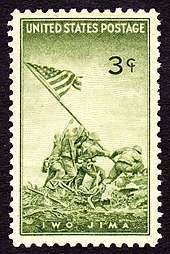
"Raising the Flag on Iwo Jima" is a black and white photograph taken by Joe Rosenthal depicting six Marines from E Company, 2nd Battalion, 28th Marines, raising a U.S. flag atop Mount Suribachi on February 23, 1945,[17] which was the second of two flag-raisings on the site that day. The photograph was extremely popular, being reprinted in thousands of publications. Later, it became the only photograph to win the Pulitzer Prize for Photography in the same year as its publication, and ultimately came to be regarded as one of the most significant and recognizable images of the war, and possibly the most reproduced photograph of all time.[17] The flag raising picture was later used by Felix de Weldon to sculpt the Marine Corps War Memorial which is located adjacent to Arlington National Cemetery since 1954.[17]
Three of the six Marines depicted in the photograph, Sergeant Michael Strank, Corporal Harlon Block, and Private First Class Franklin Sousley, were killed in action days after the flag-raising. Surviving flag-raiser Private First Class Ira Hayes, together with Private First Class Rene Gagnon and Navy corpsman John Bradley, became celebrities upon their participation in a war bond selling tour after the battle; three subsequent Marine Corps investigations into the identities of the six men in the photograph determined: in 1946 and 1947, that Henry Hansen was incorrectly identified as being Harlon Block (both were killed six days after the photo was taken), in May and June 2016, that John Bradley was not in the photograph and Private First Class Harold Schultz was,[44] and in 2019, that Rene Gagnon was not in the photograph and Private First Class Harold Keller was.[45]
By the morning of 23 February, Mount Suribachi was effectively cut off above ground from the rest of the island. The Marines knew that the Japanese defenders had an extensive network of below-ground defenses, and that in spite of its isolation above ground, the volcano was still connected to Japanese defenders via the tunnel network. They expected a fierce fight for the summit. Two small patrols from two rifle companies from the 2/28 Marines were sent up the volcano to reconnoiter routes on the mountain's north face. The recon patrols made it to the summit and scrambled down again, reporting any contact to the 2/28 Marines commander, Lieutenant Colonel Chandler W. Johnson.[35]
Popular accounts embroidered by the press in the aftermath of the release of the photo of the flag raising, had the Marines fighting all the way up to the summit. Although the Marine riflemen expected an ambush, the larger patrol going up afterwards encountered a few Japanese defenders once on top and after the flag was raised. The majority of the Japanese troops stayed in the tunnel network due to U.S. shelling, only occasionally attacking in small groups, and were generally all killed. Johnson called for a reinforced platoon size patrol from E Company to climb Suribachi and seize and occupy the crest. The patrol commander, 1st Lt. Harold Schrier, was handed the battalion's American flag to be raised on top to signal Suribachi's capture, if they reached the summit. Johnson and the Marines anticipated heavy fighting, but the patrol encountered only a small amount of sniper fire on the way up the mountain. Once the top was secured by Schrier and his men, a length of Japanese water pipe was found there among the wreckage, and the American flag was attached to the pipe and then raised and planted on top of Mount Suribachi which became the first foreign flag to fly on Japanese soil.[46] Photographs of the flag and some of the patrol members around it were taken by Marine photographer Louis R. Lowery, the only photographer who had accompanied Lt. Schrier's patrol up the mountain.
As the flag went up, Secretary of the Navy James Forrestal had just landed on the beach at the foot of Mount Suribachi and decided that he wanted the flag as a souvenir. Colonel Johnson, the battalion's commander, believed that the flag belonged to the 2nd Battalion, 28th Marines, who had captured that section of the island. In the early afternoon, Johnson sent Pfc. Rene Gagnon, a runner (messenger) from his battalion for E Company, to take a larger flag up the volcano to replace the smaller and less visible flag. The replacement flag was attached to another and heavier section of water pipe and six Marines proceeded to raise it into place as the smaller flag was taken down and delivered to the battalion's headquarters down below. It was during this second flag-raising that Joseph Rosenthal took his exceptionally famous photograph Raising the Flag on Iwo Jima. The second flag flew on Mount Suribachi until it was taken down on March 14, when at the same time an American flag was officially raised up a flagpole during a ceremony at the V Amphibious Corps command post near Mount Suribachi which was ordered by Lt. Gen. Holland Smith the commander of all the troops on Iwo Jima. Major General Graves B. Erskine, the commander of the 3rd Marine Division was also at the event with other troops of the division.
Northern Iwo Jima
Despite Japan's loss of Mount Suribachi on the south end of the island, the Japanese still held strong positions on the north end. The rocky terrain vastly favored defense, even more so than Mount Suribachi, which was much easier to hit with naval artillery fire. Coupled with this, the fortifications constructed by Kuribayashi were more impressive than at the southern end of the island.[47] Remaining under the command of Kuribayashi was the equivalent of eight infantry battalions, a tank regiment, and two artillery and three heavy mortar battalions. There were also about 5,000 gunners and naval infantry. The most arduous task left to the Marines was the overtaking of the Motoyama Plateau with its distinctive Hill 382 and Turkey knob and the area in between referred to as the Amphitheater. This formed the basis of what came to be known as the "meatgrinder". While this was being achieved on the right flank, the left was clearing out Hill 362 with just as much difficulty. The overall objective at this point was to take control of Airfield No. 2 in the center of the island. However, every "penetration seemed to become a disaster" as "units were raked from the flanks, chewed up, and sometimes wiped out. Tanks were destroyed by interlocking fire or were hoisted into the air on the spouting fireballs of buried mines".[48] As a result, the fighting bogged down, with American casualties piling up. Even capturing these points was not a solution to the problem since a previously secured position could be attacked from the rear by the use of the tunnels and hidden pillboxes. As such, it was said that "they could take these heights at will, and then regret it".[49]
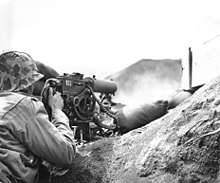
.jpg)
The Marines nevertheless found ways to prevail under the circumstances. It was observed that during bombardments, the Japanese would hide their guns and themselves in the caves only to reappear when the troops would advance and lay devastating fire on them. The Japanese had over time learned basic American strategy, which was to lay heavy bombardment before an infantry attack. Consequently, General Erskine ordered the 9th Marine Regiment to attack under the cover of darkness with no preliminary barrage. This came to be a resounding success with many Japanese soldiers killed while still asleep. This was a key moment in the capture of Hill 362.[50] It held such importance that the Japanese organized a counterattack the following night. Although Kuribayashi had forbidden the suicide charges familiar with other battles in the Pacific, the commander of the area decided on a banzai charge with the optimistic goal of recapturing Mount Suribachi. On the evening of 8 March, Captain Samaji Inouye and his 1,000 men charged the American lines, inflicting 347 casualties (90 deaths). The Marines counted 784 dead Japanese soldiers the next day.[47] The same day, elements of the 3rd Marine Division reached the northern coast of the island, splitting Kuribayashi's defenses in two.[51] There was also a kamikaze air attack (the only one of the battle) on the ships anchored at sea on 21 February, which resulted in the sinking of the escort carrier USS Bismarck Sea, severe damage to USS Saratoga, and slight damage to the escort carrier USS Lunga Point, an LST, and a transport.[50]
Although the island was declared secure at 18:00 on 16 March (25 days after the landings), the 5th Marine Division still faced Kuribayashi's stronghold in a gorge 640 m (700 yd) long at the northwestern end of the island. On 21 March, the Marines destroyed the command post in the gorge with four tons of explosives and on 24 March, Marines sealed the remaining caves at the northern tip of the island.[52] However, on the night of 25 March, a 300-man Japanese force launched a final counterattack in the vicinity of Airfield No. 2. Army pilots, Seabees, and Marines of the 5th Pioneer Battalion and 28th Marines fought the Japanese force for up to 90 minutes, suffering heavy casualties (53 killed, 120 wounded). Although still a matter of speculation because of conflicting accounts from surviving Japanese veterans, it has been said that Kuribayashi led this final assault,[6] which unlike the loud banzai charge of previous battles, was characterized as a silent attack. If ever proven true, Kuribayashi would have been the highest ranking Japanese officer to have personally led an attack during World War II. Additionally, this would also be Kuribayashi's final act, a departure from the normal practice of the commanding Japanese officers committing seppuku behind the lines while the rest perished in the banzai charge, as happened during the battles of Saipan and Okinawa. The island was officially declared secure at 09:00 on 26 March.
Once the island was officially declared secure, the Army's 147th Infantry Regiment was ostensibly there to act as a garrison force, but they soon found themselves locked in a bitter struggle against thousands of stalwart defenders engaging in a last-ditch guerrilla campaign to harass the Americans.[53] Using well-supplied caves and tunnel systems, the Japanese resisted American advances. For three months, the 147th slogged across the island, using flamethrowers, grenades, and satchel charges to dig out the enemy, killing some 1,602 Japanese soldiers in small unit actions.
Weapons

The United States M2 flamethrower was heavily used in the Pacific. It features two tanks containing fuel and compressed gas respectively, which are combined and ignited to produce a stream of flaming liquid out of the tip.[54]
These flamethrowers were used to kill Japanese holed into pillboxes, buildings and caves. A battalion would assign one flamethrower per platoon with one reserve flamethrower in each group. Flamethrower operators were usually in more danger than regular troops as the short range of their weapon required close combat, and the visibility of the flames on the battlefield made them a prominent target for snipers. Still they were essential to breaking the enemy and one battalion commander called the flamethrower the "best single weapon of the operation."[55]

Marines later experimented putting flamethrowers on tanks which were also deployed during battle. Their effectiveness was more limited due to Iwo Jima's rough terrain. A flamethrower tank would have a range of approximately 100 yd (90 m), carry 300 US gallons (1,100 l) of fuel and have a firing time of 150 seconds.[55]
Aftermath
The last of these holdouts on the island, two of Lieutenant Toshihiko Ohno's men, Yamakage Kufuku (山蔭光福, Yamakage Koufuku) and Matsudo Linsoki (松戸利喜夫, Matsudo Rikio), lasted four years without being caught and finally surrendered on 6 January 1949.[56][57][58]
Though ultimately victorious, the American victory at Iwo Jima had come at a terrible price. According to the official Navy Department Library website, "The 36-day (Iwo Jima) assault resulted in more than 26,000 American casualties, including 6,800 dead."[59] By comparison, the much larger scale 82-day Battle of Okinawa lasting from early April until mid-June 1945 (involving five U.S. Army and two Marine Corps divisions) resulted in over 62,000 U.S. casualties, of whom over 12,000 were killed or missing. Iwo Jima was also the only U.S. Marine battle where the American casualties exceeded the Japanese,[14] although Japanese combat deaths numbered three times as many as American deaths. Two US Marines were captured during the battle, neither of whom survived their captivity. The USS Bismarck Sea was also lost, the last U.S. aircraft carrier sunk in World War II.[6] Because all civilians had been evacuated, there were no civilian casualties at Iwo Jima, unlike at Saipan and Okinawa.[60]
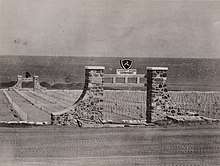 Foreground 3rd USMC Division Cemetery; left background is 4th USMC Division Cemetery Iwo Jima.
Foreground 3rd USMC Division Cemetery; left background is 4th USMC Division Cemetery Iwo Jima..jpg) Building of the 4th USMC Division Cemetery Iwo Jima
Building of the 4th USMC Division Cemetery Iwo Jima.jpg) 4th USMC Division Cemetery Iwo Jima
4th USMC Division Cemetery Iwo Jima.jpg) 5th USMC Division Cemetery Iwo Jima
5th USMC Division Cemetery Iwo Jima
Strategic importance

In hindsight, given the number of casualties, the necessity and long-term significance of the island's capture to the outcome of the war became a contentious issue and remains disputed.[61] The Marines, who suffered the actual casualties, were not consulted in the planning of the operation.[62] As early as April 1945, retired Chief of Naval Operations William V. Pratt stated in Newsweek magazine that considering the "expenditure of manpower to acquire a small, God-forsaken island, useless to the Army as a staging base and useless to the Navy as a fleet base ... [one] wonders if the same sort of airbase could not have been reached by acquiring other strategic localities at lower cost."[9]
The lessons learned on Iwo Jima served as guidelines for the following Battle of Okinawa and the planned invasion of the Japanese homeland. For example, "because of the casualties taken at Iwo Jima on the first day, it was decided to make the preparatory bombardment the heaviest yet delivered on to a Pacific island".[63] Also, in the planning for a potential attack on the Japanese home islands, it was taken into account that around a third of the troops committed to Iwo Jima and again at Okinawa had been killed or wounded.[64]
The justification for Iwo Jima's strategic importance to the United States' war effort has been that it provided a landing and refueling site for long-range fighter escorts. These escorts proved both impractical and unnecessary, and only ten such missions were ever flown from Iwo Jima.[65] By the time Iwo Jima had been captured, the bombing campaign against Japan had switched from daylight precision bombing to nighttime incendiary attacks, so fighter escorts were of limited utility.
Japanese fighter aircraft based on Iwo Jima sometimes attacked AAF planes, which were vulnerable on their way to Japan because they were heavily laden with bombs and fuel. However, although some Japanese interceptors were based on Iwo Jima, their impact on the American bombing effort was marginal; in the three months before the invasion only 11 B-29s were lost as a result.[67] The Superfortresses found it unnecessary to make any major detour around the island.[68] Capturing the island neutralized Japanese air attacks based from it on the Marianas, but they were too small to ever launch significant attacks.
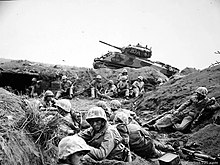
The Japanese on Iwo Jima had radar[69] and were thus able to notify their comrades at home of incoming B-29 Superfortresses flying from the Mariana Islands. However, the capture of Iwo Jima did not affect the Japanese early-warning radar system, which continued to receive information on incoming B-29s from the island of Rota (which was never invaded).[70]
As early as 4 March 1945, while fighting was still taking place, the B-29 Dinah Might of the USAAF 9th Bomb Group reported it was low on fuel near the island and requested an emergency landing. Despite enemy fire, the airplane landed on the Allied-controlled section of the island (South Field), without incident, and was serviced, refueled and departed.
In all, 2,251 B-29 landings on Iwo Jima were recorded during the war.[71] Moskin records that 1,191 fighter escorts and 3,081 strike sorties were flown from Iwo Jima against Japan.[72] A more recent Air Force study found the contribution of VII Fighter Command superfluous. Another rationale for capturing the island was to serve as a base for shorter-range B-24 Liberator bombers against Japan, but no significant B-24 bombing campaign ever materialized.
Some downed B-29 crewmen were saved by air-sea rescue aircraft and vessels operating from the island, but Iwo Jima was only one of many islands that could have been used for such a purpose. As for the importance of the island as a landing and refueling site for bombers, Marine Captain Robert Burrell, then a history instructor at the United States Naval Academy, suggested that only a small proportion of the 2,251 landings were for genuine emergencies, the great majority possibly being for minor technical checkups, training, or refueling. According to Burrell,
This justification became prominent only after the Marines seized the island and incurred high casualties. The tragic cost of Operation Detachment pressured veterans, journalists, and commanders to fixate on the most visible rationalization for the battle. The sight of the enormous, costly, and technologically sophisticated B-29 landing on the island's small airfield most clearly linked Iwo Jima to the strategic bombing campaign. As the myths about the flag raisings on Mount Suribachi reached legendary proportions, so did the emergency landing theory in order to justify the need to raise that flag.[73]
The "emergency landing" thesis counts every B-29 landing on Iwo Jima as an emergency and asserts that capturing the island saved the lives of the nearly 25,000 crewmen of all 2,251 planes (2,148 B-29 crewmen were killed in combat during the whole war in all theaters). However, of the nearly 2,000 B-29s which landed from May–July 1945, more than 80% were for routine refueling. Several hundred landings were made for training purposes, and most of the remainder were for relatively minor engine maintenance. During June 1945 which saw the largest number of landings, none of the more than 800 B-29s that landed on the island did so due to combat damage. Of the aircraft that would have been lost without being able to land, air-sea rescue figures indicate that 50% of crewmen who ditched at sea survived, so taking Iwo Jima would not have been a necessity to save them.
In publishing The Ghosts of Iwo Jima, Texas A&M University Press said that the very losses formed the basis for a "reverence for the Marine Corps" that not only embodied the "American national spirit" but ensured the "institutional survival" of the Marine Corps.[74]
Medal of Honor recipients

The Medal of Honor is the highest military decoration awarded by the United States government. It is bestowed on a member of the United States armed forces who distinguishes himself by "... conspicuous gallantry and intrepidity at the risk of his life above and beyond the call of duty while engaged in an action against an enemy of the United States ..." Because of its nature, the medal is commonly awarded posthumously; since its creation during the American Civil War it has been presented only 3,464 times.
The Medal of Honor was awarded to 27 U.S. Marines and U.S. sailors (14 posthumously), during the battle of Iwo Jima. 22 medals were presented to Marines (12 posthumously) and 5 were presented to sailors, 4 of whom were hospital corpsmen (2 posthumously) attached to Marine infantry units; 22 Medals of Honor was 28% of the 82 awarded to Marines in World War II.[75]
Hershel W. Williams (Marine Corps) is the only living Medal of Honor recipient from the Battle of Iwo Jima, and of the Pacific theatre. Williams (age 96 in 2019) and Charles H. Coolidge (U.S. Army, for actions in European theatre, age 98 in 2019) are the only living Medal of Honor recipients from World War II.
Legacy

The Marine Corps War Memorial (Iwo Jima Memorial) was dedicated on 10 November 1954.
The United States Navy has commissioned two ships with the name USS Iwo Jima (LPH-2) (1961–1993) and USS Iwo Jima (LHD-7) (2001–present).
On 19 February 1985, the 40th anniversary of the landings on Iwo Jima, an event called the "Reunion of Honor" was held (the event has been held annually since 2002).[76] The veterans of both sides who fought in the battle of Iwo Jima attended the event. The place was the invasion beach where U.S. forces landed. A memorial on which inscriptions were engraved by both sides was built at the center of the meeting place. Japanese attended at the mountain side, where the Japanese inscription was carved, and Americans attended at the shore side, where the English inscription was carved.[77] After unveiling and offering of flowers were made, the representatives of both countries approached the memorial; upon meeting, they shook hands. The combined Japan-U.S. memorial service of the 50th anniversary of the battle was held in front of the monument in February 1995.[78] Further memorial services have been held on later anniversaries.
The importance of the battle to Marines today is demonstrated in pilgrimages made to the island, and specifically the summit of Suribachi.[79] Marines will often leave dog tags, rank insignia, or other tokens at the monuments in homage.[80] Iwo Jima Day is observed annually on 19 February in the Commonwealth of Massachusetts[81] with a ceremony at the State House.
The Japanese government continues to search for and retrieve the remains of Japanese military personnel who were killed during the battle.[82]
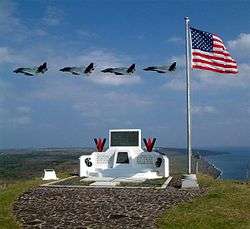 The memorial on top of Suribachi
The memorial on top of Suribachi The 60th anniversary reunion at the Japanese part of the memorial
The 60th anniversary reunion at the Japanese part of the memorial.jpg) The 67th anniversary ceremony sponsored by the U.S. Marine Corps, the government of Japan, and the Iwo Jima Associations of America and Japan
The 67th anniversary ceremony sponsored by the U.S. Marine Corps, the government of Japan, and the Iwo Jima Associations of America and Japan Commencement of the 71st commemoration of the anniversary
Commencement of the 71st commemoration of the anniversary U.S. and Japanese color guard teams stand at attention during the 72nd Reunion of Honor ceremony.
U.S. and Japanese color guard teams stand at attention during the 72nd Reunion of Honor ceremony.
Movies and documentaries
- To the Shores of Iwo Jima, a 1945 American documentary produced by the United States Navy, Marine Corps, and Coast Guard
- Glamour Gal, a 1945 film about Marine artillery
- Sands of Iwo Jima, a 1949 American film starring John Wayne
- The Outsider, a 1961 film starring Tony Curtis as the conflicted flag raiser Ira Hayes[83]
- Episode 23 from the acclaimed 1973 Thames Television documentary The World at War
- The League of Grateful Sons, a 2005 documentary by Vision Forum
- Flags of Our Fathers and Letters from Iwo Jima, two 2006 films directed by Clint Eastwood. Flags of Our Fathers is filmed from the American perspective and is based on the book by James Bradley and Ron Powers (Flags of Our Fathers). Letters from Iwo Jima (originally titled Red Sun, Black Sand) is filmed from the Japanese perspective.
- Part 8 of the 2010 HBO miniseries The Pacific, produced by Tom Hanks and Steven Spielberg, includes part of the Battle of Iwo Jima from the point of view of John Basilone from the beginning of the invasion until his death later in the day.
Video games
- Battlefield V: War in the Pacific (2018)
- Rising Storm: Game of the Year Edition (2013)
See also
| Library resources about Battle of Iwo Jima |
Notes
- PacificWrecks.com. "Pacific Wrecks".
- Burrell 2006, p. 83. Burrell talks Archived 2 January 2016 at the Wayback Machine about how many historians have overestimated the number Japanese defenders, with 20,000 and even 25,000 listed. Burrell puts the range between 18,060 and 18,600, with exactly 216 of these taken prisoner during the course of the battle. Another 867 prisoners were taken by the U.S. Army between April and June, after the Marines had left.
- Taki, "The History of Battles of Imperial Japanese Tanks" Archived 4 March 2016 at the Wayback Machine.
- Crumley, B.L. The Marine Corps: Three Centuries of Glory. Archived from the original on 18 March 2020.
- The total breaks down as follows: 361 artillery pieces of 75 mm caliber or larger, 12 320 mm spigot mortars, 65 medium and light mortars, 33 naval guns, 94 anti-aircraft guns of 75 mm or larger, 200+ anti-aircraft guns of 20 mm or 25 mm, and 69 37 mm or 47 mm anti-tank guns.
- Morison, Samuel Eliot (2002) [1960]. Victory in the Pacific, 1945. Volume 14 of History of United States Naval Operations in World War II. Urbana: University of Illinois Press. ISBN 0-252-07065-8. OCLC 49784806.
- "Survey of Allied tank casualties in World War II" Archived 17 July 2019 at the Wayback Machine, Technical Memorandum ORO-T-117, Department of the Army, Washington D.C., Table 1.
- John Toland, The Rising Sun: The Decline and Fall of the Japanese Empire, 1936–1945, p. 669
- Pratt, William V. (2 April 1945). "What Makes Iwo Jima Worth the Price". Newsweek. p. 36.
- "John Clements Collection". loc.gov. Archived from the original on 2 April 2015. Retrieved 28 August 2014.
- "Letters from Iwo Jima". World War II Multimedia Database. Archived from the original on 12 December 2007.
- "Battle of Iwo Jima – Japanese Defense". World War II Naval Strategy. Archived from the original on 17 April 2016. Retrieved 17 February 2009.
- Video: Carriers Hit Tokyo! 1945/03/19 (1945). Universal Newsreel. 19 March 1945. Archived from the original on 3 November 2012. Retrieved 22 February 2012.
- O'Brien, Cyril J. "Iwo Jima Retrospective". Archived from the original on 7 June 2007. Retrieved 21 June 2007.
- John Toland, Rising Sun: The Decline and Fall of the Japanese Empire 1936–1945, p. 669
- Adrian R. Lewis, The American Culture of War: The History of U.S. Military Force from World War II to Operation Iraqi Freedom, New York 2007, p. 59
- Landsberg, Mitchell (1995). "Fifty Years Later, Iwo Jima Photographer Fights His Own Battle". Associated Press. Archived from the original on 5 September 2007. Retrieved 11 September 2007.
- USA, FEC, HistDiv, "Operations in the Central Pacific" – Japanese Studies in World War II (Japanese Monograph No. 48, OCMH), p. 62.; cited in George W. Garand and Truman R. Strobridge (1971). History of U.S. Marine Corps Operations in World War II Archived 17 February 2009 at the Wayback Machine. Historical Branch, G-3 Division, Headquarters, U.S. Marine Corps. Vol IV, Part VI, Ch 1.
- King, Dan (2014). A Tomb Called Iwo Jima. Pacific Press. pp. 58–59. ISBN 978-1500343385.
- Hammel, Eric (2006). Iwo Jima. Minneapolis: Zenith Press. p. 36. ISBN 978-0-7603-3733-2.
- King, Dan (2014). A Tomb Called Iwo Jima. Pacific Press. p. 80. ISBN 978-1-5003-43385.
- "History of Imperial General Headquarters Army Section, p. 257". Archived from the original on 6 April 2016. Retrieved 31 May 2016.
- Wright. Iwo Jima:1945. p. 51.
- "Chronology of the Battle of Iwo Jima". Archived from the original on 7 July 2010.
- Wright, Iwo Jima 1945: The Marines Raise the Flag on Mount Suribachi, p. 22
- Wright, Iwo Jima 1945: The Marines Raise the Flag on Mount Suribachi, pp. 22–23
- "Naval Gunfire". Retrieved 28 February 2011.
- "United States Marine Corps War Memorial". The George Washington University. Archived from the original on 29 June 2011. Retrieved 28 February 2011.
- Wright 2004, p. 91 except where noted.
- Wright, Iwo Jima 1945: The Marines Raise the Flag on Mount Suribachi, pp. 12–13, 80–81
- "Amphibious Operations: Capture of Iwo Jima". Naval History and Heritage Command. Archived from the original on 8 September 2015. Retrieved 5 September 2015.
- Wright, Iwo Jima 1945: The Marines Raise the Flag on Mount Suribachi, p. 23
- "Navajo Code Talkers: World War II Fact Sheet" Archived 4 November 2017 at the Wayback Machine. Naval Historical Center. 1992. Retrieved 2014-03-12.
- Wright, Iwo Jima 1945: The Marines Raise the Flag on Mount Suribachi, p. 26
- Allen, Robert E. (2004). The First Battalion of the 28th Marines on Iwo Jima: A Day-by-Day History from Personal Accounts and Official Reports, with Complete Muster Rolls. Jefferson, NC: McFarland & Company. ISBN 0-7864-0560-0. OCLC 41157682.
- Wright, Iwo Jima 1945: The Marines Raise the Flag on Mount Suribachi, pp. 26–27
- Leckie, The Battle for Iwo Jima, p. 28
- Wright, Iwo Jima 1945: The Marines Raise the Flag on Mount Suribachi, p. 27
- Leckie, The Battle for Iwo Jima, p. 25
- Wright, Iwo Jima 1945: The Marines Raise the Flag on Mount Suribachi, p. 32
- Wright, Iwo Jima 1945: The Marines Raise the Flag on Mount Suribachi, pp. 30–31
- Wright, Iwo Jima 1945: The Marines Raise the Flag on Mount Suribachi, p. 31
- Wright, Iwo Jima 1945: The Marines Raise the Flag on Mount Suribachi, p. 33
- USMC Statement on Marine Corps Flag Raisers Archived 24 June 2016 at the Wayback Machine, Office of U.S. Marine Corps Communication, 23 June 2016
- "Warrior in iconic Iwo Jima flag-raising photo was misidentified, Marines Corps acknowledges". NBC News. 16 October 2019. Retrieved 2 March 2020.
- "Charles Lindberg, 86; Marine helped raise first U.S. flag over Iwo Jima". The Los Angeles Times. 26 June 2007. p. B8. Archived from the original on 22 October 2012. Retrieved 30 November 2008.
- Wheeler, Keith (1979). The Road to Tokyo. Alexandria, VA: Time-Life Books. p. 50. ISBN 0-8094-2540-8.
- Leckie, Robert (1987). Delivered from Evil. New York: Harper & Row. p. 870. ISBN 0-06-091535-8.
- Leckie, Robert (1987). Delivered from Evil. New York: Harper & Row. p. 871. ISBN 0-06-091535-8.
- Leckie, Robert (1987). Delivered from Evil. New York: Harper & Row. p. 872. ISBN 0-06-091535-8.
- "Operation Detachment: The Battle for Iwo Jima February – March 1945". historyofwar.org. Archived from the original on 15 February 2009. Retrieved 17 February 2009.
- Moskin, pp. 372–373
- "The Curious Case of the Ohio National Guard's 147th Infantry". 6 December 2015. Archived from the original on 3 October 2016. Retrieved 26 June 2016.
- "Flamethrower". Archived from the original on 28 June 2011. Retrieved 28 February 2011.
- "The Flame Thrower in the Pacific: Marianas to Okinawa". Archived from the original on 14 March 2010. Retrieved 28 February 2011.
- "Japanese Surrender After Four Year Hiding". Pacific Stars and Stripes. 10 January 1949. p. 5. Archived from the original on 17 July 2013.
- Cook, Donald. "Capture of Two Holdouts January 6, 1949". No Surrender: Japanese Holdouts. Archived from the original on 9 October 2007. Retrieved 11 September 2007.
- 山蔭光福; 松戸利喜夫 (1968), 硫黄島最後の二人 (in Japanese), 読売新聞社
- "Battle for Iwo Jima, 1945". Navy Department Library. 19 October 2006. Archived from the original on 7 April 2010. Retrieved 23 August 2015.
- "This Month in History: Selected March Dates of Marine Corps Historical Significance". United States Marine Corps History Division. Archived from the original on 28 November 2010. Retrieved 23 August 2015.
- "The Battle of Iwo Jima". History Department at the University of San Diego. Archived from the original on 20 July 2009. Retrieved 10 March 2010.
- See Burrell, Robert S. (2004). "Breaking the cycle of Iwo Jima mythology: a strategic study of Operation Detachment". Journal of Military History. 68 (4): 1143–1186. doi:10.1353/jmh.2004.0175.
- John Keegan, The Second World War. Penguin books, 1989, p. 566
- John Keegan, p. 575
- Assistant Chief of Air Staff (September–October 1945). "Iwo, B-29 Haven and Fighter Springboard". Impact. pp. 69–71.
- Craven, Wesley Frank; James Lea Cate (1953). The Army Air Forces in World War II. Chicago: University of Chicago Press. pp. 5:581–582. ISBN 0-226-11995-5. OCLC 704158.
- Craven and Cate, 5:559.
- Newcomb, Richard F. (2002). Iwo Jima. Holt Paperbacks. p. 59. ISBN 0-8050-7071-0.
- Joint War Planning Committee 306/1, "Plan for the Seizure of Rota Island," 25 January 1945.
- "Iwo To Japan". 506th Fighter Group. Archived from the original on 8 February 2010. Retrieved 10 March 2010.
- Moskin, J.Robert (1992). The U.S. Marine Corps Story (3rd Revised ed.). Little, Brown and Company. p. 373. ISBN 0-448-22688-X.
- Burrell, Robert S. (October 2004). "Breaking the Cycle of Iwo Jima Mythology: A Strategic Study of Operation Detachment". The Journal of Military History. 68 (4): 1143–1186. doi:10.1353/jmh.2004.0175. OCLC 37032245.
- "The Ghosts of Iwo Jima". Texas A&M University Press. 2006. Archived from the original on 1 January 2014. Retrieved 14 July 2007.
- "United States Army Center of Military History Medal of Honor Citations Archive". Medal Of Honor Statistics. United States Army Center of Military History. 16 July 2007. Archived from the original on 9 August 2011. Retrieved 6 March 2008.
- Jeanette Steele (13 March 2014). "Iwo Jima: A veteran returns". UT San Diego. Archived from the original on 6 April 2014. Retrieved 6 April 2014.
- Reunion of Honor Memorial Archived 19 March 2014 at the Wayback Machine Retrieved 14 July 2013.
- Iwo Jima 50th anniversary US, Japanese vets to meet on Iwo Jima Archived 19 January 2018 at the Wayback Machine. UPI
- Blumenstein, LCpl Richard; Sgt. Ethan E. Rocke (October–December 2007). "From Black Sands to Suribachi's Summit: Marines Reflect on Historic Battle". Marines Magazine. United States Marine Corps. Archived from the original on 11 February 2009. Retrieved 18 December 2008.
- See: File:IwoJima Homage Insignia Devices.jpg
- "The General Laws of Massachusetts – Declaration of Iwo Jima Day". Commonwealth of Massachusetts. Archived from the original on 5 March 2010. Retrieved 9 March 2010.
- Kyodo News, "Map of Iwojima's underground bunkers found in U.S. Archived 19 May 2012 at the Wayback Machine", Japan Times, 6 May 2012, p. 2.
- "Outsider (1961)". Internet Movie Database. Archived from the original on 22 October 2007. Retrieved 2 January 2008.
References
- Allen, Robert E. (2004). The First Battalion of the 28th Marines on Iwo Jima: A Day-by-Day History from Personal Accounts and Official Reports, with Complete Muster Rolls. Jefferson, NC: McFarland & Company. ISBN 0-7864-0560-0. OCLC 41157682.
- Bradley, James; Ron Powers (2001) [2000]. Flags of Our Fathers. New York: Bantam. ISBN 0-553-38029-X. OCLC 48215748.
- Bradley, James (2003). Flyboys: A True Story of Courage. Boston: Little, Brown and Company. ISBN 0-316-10584-8. OCLC 52071383.
- Buell, Hal (2006). Uncommon Valor, Common Virtue: Iwo Jima and the Photograph that Captured America. New York: Penguin Group. ISBN 0-425-20980-6. OCLC 65978720.
- Burrell, Robert S. "Breaking the Cycle of Iwo Jima Mythology: A Strategic Study of Operation Detachment," Journal of Military History Volume 68, Number 4, October 2004, pp. 1143–1186 and rebuttal in Project MUSE
- Burrell, Robert S. (2006). The Ghosts of Iwo Jima. College Station: Texas A&M University Press. ISBN 1-58544-483-9. OCLC 61499920.
- Eldridge, Robert D.; Charles W. Tatum (2011). Fighting Spirit: The Memoirs of Major Yoshitaka Horie and the Battle of Iwo Jima. Annapolis: Naval Institute Press. ISBN 978-1-59114-856-2.
- Hammel, Eric (2006). Iwo Jima: Portrait of a Battle: United States Marines at War in the Pacific. St. Paul, MN: Zenith Press. ISBN 0-7603-2520-0. OCLC 69104268.
- Hearn, Chester (2003). Sorties into @#!* % : The Hidden War on Chichi Jima. Westport, CN: Praeger Publishers. ISBN 0-275-98081-2. OCLC 51968985.
- Kakehashi, Kumiko (2007). So Sad to Fall in Battle: An Account of War Based on General Tadamichi Kuribayashi's Letters from Iwo Jima. Presidio Press. ISBN 978-0-89141-917-4.
- Kirby, Lawrence F. (1995). Stories From The Pacific: The Island War 1942–1945. Manchester, MA: The Masconomo Press. ISBN 0-9645103-1-6. OCLC 32971472.
- Leckie, Robert (2005) [1967]. The Battle for Iwo Jima. New York: ibooks, Inc. ISBN 1-59019-241-9. OCLC 56015751.
- Linenthal, Edward T. "Shaping a Heroic Presence: Iwo Jima in American Memory". Reviews in American History Vol. 21, No. 1 (March 1993), pp. 8–12. JSTOR 2702942.
- Lucas, Jack; D.K. Drum (2006). Indestructible: The Unforgettable Story of a Marine Hero at the Battle of Iwo Jima. Cambridge, MA: Da Capo Press. ISBN 0-306-81470-6. OCLC 68175700.
- Morison, Samuel Eliot (2002) [1970]. Victory in the Pacific, 1945, vol. 14 of History of United States Naval Operations in World War II. Urbana: University of Illinois Press. ISBN 0-252-07065-8. OCLC 49784806.
- Newcomb, Richard F.; Harry Schmidt (2002) [1965]. Iwo Jima. New York: Owl Books. ISBN 0-8050-7071-0. OCLC 48951047.
- Overton, Richard E. (2006). God Isn't Here: A Young American's Entry into World War II and His Participation in the Battle for Iwo Jima. Clearfield, UT: American Legacy Media. ISBN 0-9761547-0-6. OCLC 60694955.
- Rawson, Andrew. 2016. Iwo Jima 1945, Toronto: Dundurn.
- Ross, Bill D. (1986) [1985]. Iwo Jima: Legacy of Valor. New York: Vintage. ISBN 0-394-74288-5. OCLC 13582622.
- Shively, John C. (2006). The Last Lieutenant: A Foxhole View of the Epic Battle for Iwo Jima. Bloomington: Indiana University Press. ISBN 0-253-34728-9. OCLC 61761637.
- Toyn, Gary W. (2006). The Quiet Hero: The Untold Medal of Honor Story of George E. Wahlen at the Battle for Iwo Jima. Clearfield, UT: American Legacy Media. ISBN 0-9761547-1-4. OCLC 72161745.
- Veronee, Marvin D. (2001). A portfolio of photographs: selected to illustrate the setting for my experience in the battle of Iwo Jima, World War II, Pacific theater. Quantico, VA: Visionary Pub. ISBN 0-9715928-2-9. OCLC 52001277.
- Wells, John K. (1995). Give Me Fifty Marines Not Afraid to Die: Iwo Jima. Abilene, TX: Quality Publications. ISBN 0-9644675-0-X. OCLC 32153036.
- Wheeler, Richard (1994) [1980]. Iwo. Annapolis, MD: Naval Institute Press. ISBN 1-55750-922-0. OCLC 31693687.
- Wheeler, Richard (1994) [1965]. The @#!* % Battle for Suribachi. Annapolis, MD: Naval Institute Press. ISBN 1-55750-923-9. OCLC 31970164.
- Wright, Derrick (2007) [1999]. The Battle for Iwo Jima 1945. Stroud: Sutton Publishing. ISBN 978-0-7509-4544-8. OCLC 67871973.
- Wright, Derrick (2004) [2001]. Iwo Jima 1945: The Marines Raise the Flag On Mount Suribachi. Oxford: Osprey Publishing Ltd. ISBN 0-275-98273-4.
- Kindersley, Dorling (2009). World War II: The Definitive Visual History. DK Publishing.
Online
- Alexander, Joseph H. (1994). Closing In: Marines in the Seizure of Iwo Jima. Marines in World War II Commemorative Series. Washington, DC: History and Museums Division, Headquarters, United States Marine Corps. OCLC 32194668.
- Bartley, Whitman S. (1954). Iwo Jima: Amphibious Epic. Marines in World War II Historical Monograph. Washington, DC: Historical, Division of Public Information, Headquarters, United States Marine Corps. OCLC 28592680.
- Garand, George W.; Truman R. Strobridge (1971). "Part VI: Iwo Jima". Western Pacific Operations. Volume IV of History of U.S. Marine Corps Operations in World War II. Historical Branch, United States Marine Corps. ISBN 0-89839-198-9.
- Dyer, George Carroll (1956). "The Amphibians Came to Conquer: The Story of Admiral Richmond Kelly Turner". United States Government Printing Office. Archived from the original on 21 May 2011. Retrieved 5 May 2011.
- "Animated Map History of The Battle of Iwo Jima (including Medal of Honor citations)". HistoryAnimated.com. Archived from the original on 22 October 2007. Retrieved 22 September 2007.
- "The Battle for Iwo Jima (color combat footage)". SonicBomb.com.
- Brady, John H. "Iwo Jima". Iwo Jima, Inc.
- "Battle of Iwo Jima". WW2DB.com. Site contains 250 photographs.
- Williams, Greg. "Dimensions of Valor". Tampa Tribune. TBO.com. Archived from the original (Flash) on 5 December 2006. 3-D stereo photograph of Iwo Jima flag-raising.
- "Iwo Jima: Forgotten Valor". Primary Source Adventures. Portal to Texas History, University of North Texas.
- Dawson, Rick (2007). "The Battle of Iwo Jima". ArticleMyriad.com. Archived from the original on 26 February 2007.
- "Iwo Jima Combat Footage in Color". WW2incolor.com. Archived from the original on 1 June 2007. Retrieved 12 May 2005.
- Lemer, Jeremy (15 February 2005). "Remembering the Battle of Iwo Jima". Columbia News Service. Archived from the original on 8 September 2006. Retrieved 6 October 2006.
- "Operations map of Iwo Jima" (JPG). 23 October 1944.
- "Collection of military maps of Iwo Jima". Historical Resources. 15 September 2008. Archived from the original on 8 January 2009. Retrieved 16 July 2017.
- "To the Shores of Iwo Jima" (video). Google Video.
- "Battle of Iwo Jima". History of War.
- Alexander, Colonel Joseph (2000). "Battle of Iwo Jima". HistoryNet.com and World War II magazine.
- "Iwo Jima Pictures". WW2-Pictures.com. Archived from the original on 16 April 2010.
- "Amphibious Operations: Capture of Iwo Jima". Naval History and Heritage Command. Retrieved 5 September 2015.
- "Victory At Sea: Target Suribachi" (video). Internet Archive. Archived from the original on 12 February 2009. Retrieved 17 January 2009.
- "Rare photos of the Battle of Iwo Jima from the U.S. National Archives and the Department of Defense, USMC". Awesome Stories. Retrieved 9 March 2010.
- "Daily summaries of fighting, Medal of Honor citations, a listing of those who died on Iwo Jima, and maps of the battle". Iwojimahistory.com. Retrieved 8 November 2011.
External links
